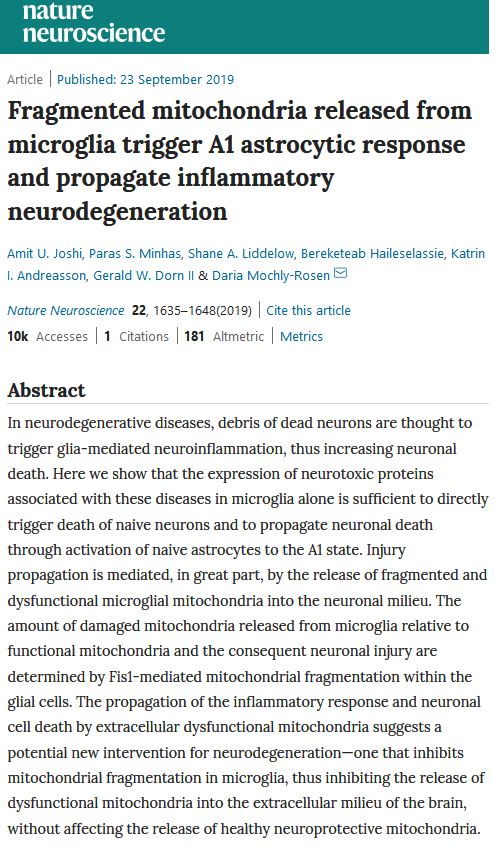13.11.2019
Fragmented mitochondria released from microglia trigger A1 astrocytic response and propagate inflammatory neurodegeneration
Nature Neuroscience 22, 2019
Efforts to reduce the personal and societal burden of neurodegenerative disease (ND) hinge on the identification of the underlying molecular mechanism(s) that causes neuronal death. One common aspect of neuronal death in Alzheimer’s disease (AD), amyotrophic lateral sclerosis (ALS), and Huntington’s disease (HD) is the relationship to the buildup of neurotoxic proteins. Glial cells, normally neuroprotective, can be transformed into a neuroinflammatory state (“A1” for astrocytes) stimulated by this neuronal detritus and by microglial activation. Interestingly, pathological mitochondrial fission mediated by Drp1-Fis1 interaction (as opposed to physiological fission through Drp1-Mff) is also a characteristic of many ND. In their new study, Joshi et al. used various mouse ND models to reveal a process where microglia expressing neurotoxic proteins released dysfunctional and fragmented mitochondria that drove A1 astrocyte-triggered neuroinflammation and subsequent innate immune-mediated neuronal death, with the resultant debris contributing to additional inflammation. Importantly, disruption of the Drp1-Fis1 interaction ameliorated these effects. The authors stressed that the fate of neurons was determined by the extracellular ratio of damaged to normal mitochondria, which was dependent on the amount of pathological fission in microglia. Together, the results suggest that inhibition of Drp1-Fis1-mediated mitochondrial fission, with the goal of increasing the ratio between functional and damaged mitochondria, may offer a new approach to neuroprotection in various NDs.
Abstract
In neurodegenerative diseases, debris of dead neurons are thought to trigger glia-mediated neuroinflammation, thus increasing neuronal death. Here we show that the expression of neurotoxic proteins associated with these diseases in microglia alone is sufficient to directly trigger death of naive neurons and to propagate neuronal death through activation of naive astrocytes to the A1 state. Injury propagation is mediated, in great part, by the release of fragmented and dysfunctional microglial mitochondria into the neuronal milieu. The amount of damaged mitochondria released from microglia relative to functional mitochondria and the consequent neuronal injury are determined by Fis1-mediated mitochondrial fragmentation within the glial cells. The propagation of the inflammatory response and neuronal cell death by extracellular dysfunctional mitochondria suggests a potential new intervention for neurodegeneration—one that inhibits mitochondrial fragmentation in microglia, thus inhibiting the release of dysfunctional mitochondria into the extracellular milieu of the brain, without affecting the release of healthy neuroprotective mitochondria.
GeneTex is proud to offer an extensive selection of antibodies for neurodegenerative disease and mitochondria research.
Please see the featured products below relevant to the study described above:
FIS1 antibody (GTX111010)
Iba1 antibody (GTX100042)
GFAP antibody (GTX108711)
TNF alpha antibody (GTX110520)
SOD1 (mutant) antibody [MS785] (GTX57211)
beta Amyloid (1-42) antibody – Conformation Specific (GTX134510)
COX4 antibody (GTX114330)
TOMM20 antibody (GTX133756)


